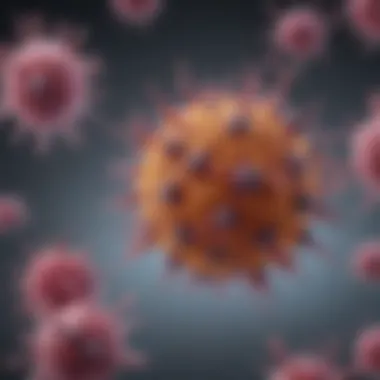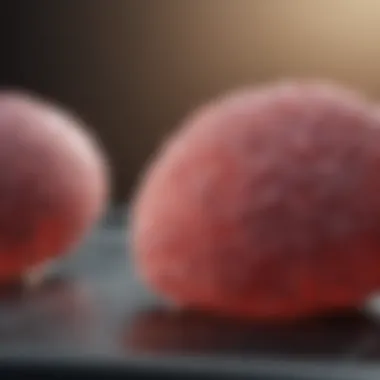Innovations in DIPG Treatment: CAR T Cell Therapy


Intro
The treatment landscape for Diffuse Intrinsic Pontine Glioma (DIPG) is challenging. This is primarily because DIPG is a highly aggressive brain tumor that substantially affects children. Traditional treatment options, such as radiation and chemotherapy, often fail to improve long-term survival rates. CAR T cell therapy emerges as a beacon of hope in this context. It's a form of immunotherapy that has shown promise in various cancers, though its application in DIPG is still in the developmental stages.
Understanding the role of CAR T cell therapy in DIPG requires a look at both the biology of the tumor and the mechanics of this innovative treatment. The conversation increasingly focuses on harnessing the power of the immune system to combat DIPG. This exploration will delve into how these treatments are being innovated, tested, and evaluated for efficacy against such a daunting adversary.
Research Overview
Summary of Key Findings
Current research indicates that CAR T cell therapy has potential mechanisms to target DIPG effectively. Recent studies have highlighted that particular antigens, such as EGFRvIII, are promising candidates for CAR T cell targeting if patients express them. The findings suggest improved immune response against tumor cells when CAR T cells are directed towards these specific proteins.
However, challenges remain. It is crucial to establish protocols to deliver this therapy safely and effectively within the brainstem, where DIPG resides. This has severely limited the applicability of CAR T therapy so far. Research is now focusing on ways to address these delivery challenges.
Methodologies Employed
Several methodologies are utilized to test CAR T cell therapy for DIPG.
- Preclinical Models: Many studies use animal models, such as mice, to evaluate the safety and efficacy of CAR T cells before advancing to human trials.
- Cell Culture Systems: In vitro studies allow for testing the interactions between CAR T cells and tumor cell lines, providing data arethe potential effectiveness and mechanisms of action in a controlled environment.
- Clinical Trials: Phase I and II trials are underway, designed to assess the safety, optimal dosing, and initial efficacy of CAR T cell therapy specifically for DIPG patients.
The integration of these methodologies helps form a clearer picture of what CAR T therapy can achieve, and what limitations must be overcome to yield positive outcomes for affected children.
Preface to DIPG
Diffuse Intrinsic Pontine Glioma (DIPG) represents a particularly challenging and aggressive form of brain cancer primarily affecting children. Understanding the intricacies of DIPG is critical for advancing treatment options and improving patient outcomes. This section serves to establish a foundation for exploring how innovations, such as CAR T cell therapy, may impact the standard of care for this devastating disease.
Definition and Characteristics
DIPG is classified as a type of glioma that occurs in the brainstem, specifically within the pons region. This tumor is characterized by its infiltrative nature, making complete surgical removal nearly impossible. Patients often present with symptoms such as difficulty in coordination, facial weakness, and problems with vision and speech. Due to its location and aggressiveness, DIPG is often diagnosed at an advanced stage, which contributes to the poor prognosis associated with this cancer.
Some unique features of DIPG include:
- Histological Features: Typically, DIPG exhibits high-grade characteristics, including significant cellular atypia and mitotic activity.
- Imaging Findings: MRI scans usually reveal an ill-defined mass with variable enhancement, often accompanied by surrounding edema.
- Age Group Impact: The age of onset generally ranges from 5 to 10 years, which is a critical period of development for pediatric patients.
Researchers continue to investigate the molecular underpinnings of DIPG, as this knowledge is essential for future targeted therapies.
Epidemiology and Demographics
The incidence of DIPG is relatively low compared to other pediatric brain tumors, accounting for approximately 10-15% of all childhood primary brain tumors. Epidemiological studies suggest that the overall incidence rate is between 0.5 and 2 cases per 100,000 children per year. Importantly, there is a higher prevalence among males compared to females.
Factors influencing demographics include:
- Age: Most cases occur between the ages of 5 and 10, reflecting a peak incidence during early childhood.
- Geographic Variation: Some studies have also indicated geographical variations in incidence, possibly linked to environmental factors, though further research is necessary.
Understanding these epidemiological patterns helps in effective planning for clinical trials and public health initiatives aimed at this vulnerable population.
Pathophysiology and Molecular Mechanisms
The pathophysiology of DIPG is complex and involves numerous molecular alterations that drive tumor growth and resistance to traditional therapies. Genetic studies have revealed that a significant percentage of DIPGs harbor mutations in the histone genes, particularly K27M mutations. These mutations lead to alterations in chromatin remodeling, thereby affecting gene expression and cell signaling pathways.
Other mechanisms include:
- Oncogenic Pathways: Dysregulation of pathways such as the PI3K-AKT and RAS-MAPK cascades often occurs, contributing to cell proliferation and survival.
- Microenvironmental Factors: The tumor microenvironment in DIPG is characterized by a dense extracellular matrix and immune evasion strategies, which complicates treatment response.
- Resistance Mechanisms: The inherent blood-brain barrier presents additional challenges, limiting the efficacy of systemic therapies.
Research into these molecular mechanisms is crucial, as elucidating these pathways can inform the development of tailored therapies, like CAR T cell therapy, which aim to address specific vulnerabilities within the tumor biology.


Current Treatment Strategies for DIPG
Effective treatment strategies for Diffuse Intrinsic Pontine Glioma (DIPG) are crucial, given the tumor’s aggressive nature and poor prognosis. These strategies often focus on managing symptoms and attempting to slow disease progression rather than achieving a cure. The combination of radiotherapy, chemotherapy, and emerging treatments forms a multi-faceted approach crucial in enhancing patient quality of life. Understanding these strategies can guide future therapeutic developments, particularly in context with innovations such as CAR T cell therapy.
Standard Radiotherapy Approaches
Radiotherapy remains a cornerstone in the treatment of DIPG. Given the tumor's location, surgery is not a viable option due to the dangers associated with its proximity to critical brain structures. Thus, radiotherapy serves as the primary treatment modality.
Typically, external beam radiotherapy is employed, targeting the tumor to reduce its size and alleviate symptoms. This treatment often spans several weeks, with high doses aimed at the tumor while minimizing exposure to surrounding healthy tissue.
Although this approach offers some benefits, such as symptom relief and potentially extending survival, it does not result in a cure. Long-term effects of radiation can also include cognitive decline and other complications, raising concerns about the balance between treatment benefits and risk of harm.
Chemotherapy Protocols
Chemotherapy has been explored as a means to complement radiotherapy in DIPG treatment. Standard protocols often involve drugs such as temozolomide or others under clinical trials. However, the effectiveness of chemotherapy in this context is controversial.
Most chemotherapy agents do not effectively penetrate the blood-brain barrier, which limits their ability to impact DIPG directly. Thus, they may provide minimal benefit in terms of tumor control. Such limitations emphasize the necessity for developing alternative agents or enhanced delivery routes that can maximize efficacy against the tumor.
Emerging Therapeutic Avenues
As researchers continue to search for more effective DIPG treatments, several emerging therapeutic strategies are being investigated. These include:
- Targeted therapies: These focus on specific molecular characteristics of tumors and may provide more effective treatment with fewer side effects.
- Immunotherapy: This area of research looks promising, especially with methods such as checkpoint inhibitors that may help the immune system recognize and attack tumor cells.
- Anti-angiogenic therapies: These aim to inhibit the blood supply to the tumor, potentially restricting its growth.
Clinical trials focused on these novel approaches are critical, as they may offer insights into treatment efficacy and pave the way for future options.
In summary, while current treatment strategies for DIPG provide limited options, they play a critical role in managing the disease. Exploring new combinations of therapies, including CAR T cell therapy, could reshape the landscape of treatment and offer hope for better outcomes in this challenging area.
Preamble to CAR T Cell Therapy
CAR T cell therapy represents a significant advancement in the field of oncology, particularly for treating aggressive forms of cancer such as Diffuse Intrinsic Pontine Glioma (DIPG). This section will elucidate the principles behind CAR T cell engineering, how these engineered cells function, and the different types that are currently in development or use. Understanding CAR T cell therapy is crucial not only for appreciating its potential applications in DIPG but also for recognizing the broader implications for immunotherapy in pediatric cancer.
Principles of CAR T Cell Engineering
The foundation of CAR T cell therapy lies in the genetic modification of T cells. The process begins with the extraction of a patient’s T cells, typically from their blood. Using a viral vector, genes that encode chimeric antigen receptors (CARs) are introduced into these T cells. This modification enables the T cells to specifically identify and attack cancer cells.
Key principles of CAR T cell engineering include:
- Specificity: CARs are designed to recognize antigens that are often overexpressed in cancer cells. In the case of DIPG, targeting antigens like GD2 or EGFRvIII is under exploration.
- Activation: Once the CAR T cells encounter their specific antigen on cancer cells, they become activated, proliferate rapidly, and initiate a cytotoxic response, leading to cancer cell death.
- Persistence: Engineered CAR T cells are expected to remain in the patient’s body long-term, providing ongoing surveillance against cancer recurrence.
The engineering of these cells is a meticulous process, requiring balancing specificity and safety to minimize damage to normal tissues.
Mechanism of Action
The mechanism of action for CAR T cells is multi-faceted, involving a cascade of biological events once the engineered cells are infused back into the patient.
When CAR T cells enter the circulation, they seek out cancer cells displaying the target antigen. Upon binding to the antigen, several actions occur:
- Granule Release: CAR T cells release lytic granules that contain perforin and granzymes, leading to pore formation in the target cell membrane and subsequent apoptosis.
- Cytokine Production: Activated CAR T cells secrete cytokines that enhance the immune response and recruit additional immune cells to the tumor site.
- Memory Formation: Some CAR T cells develop into memory cells, offering the potential for long-term immunity against cancer recurrence.
The interplay of these mechanisms emphasizes CAR T cell therapy's innovative approach to targeted cancer treatment, contrasting sharply with traditional therapies that often lack such specificity.
Types of CAR T Cells
The development of CAR T cells has led to various types, each designed to meet specific therapeutic needs. Some common types include:


- First-Generation CARs: These contain a single costimulatory domain. While better than unmodified T cells, they have limited persistence and efficacy.
- Second-Generation CARs: These features one or more costimulatory domains, providing improved T cell activation, proliferation, and durability.
- Third-Generation CARs: These are engineered by including multiple costimulatory domains and are currently being researched for enhanced efficacy.
- Dual-Target CARs: Designed to target multiple antigens, these CARs aim to improve specificity and reduce immune evasion by tumors.
Understanding the various types of CAR T cells helps identify which might be most effective for treating DIPG, leveraging their unique capabilities based on the specific tumor targets present in this aggressive brain cancer.
"The evolution of CAR T cell therapy exemplifies a remarkable intersection of technology and medicine, paving new avenues in pediatric cancer treatment."
By examining these areas, we lay the groundwork for subsequent discussion on clinical applications of CAR T cell therapy in DIPG, contextualizing its relevance in addressing the unique challenges posed by this formidable disease.
Clinical Applications of CAR T Cell Therapy in DIPG
CAR T cell therapy is a promising approach in the treatment of Diffuse Intrinsic Pontine Glioma (DIPG), a cancer that presents unique challenges due to its aggressive nature and location. By genetically modifying T cells to better identify and attack cancer cells, CAR T therapy has the potential to improve outcomes for pediatric patients significantly. This section focuses on its clinical applications, providing an overview of relevant case studies, success rates, challenges faced, and considerations for patient selection.
Case Studies and Clinical Trials
Many clinical trials are currently investigating CAR T cell therapy for DIPG. These trials aim to assess its safety and effectiveness in treating this pediatric malignancy. A notable case study involved patients treated with CAR T cells targeting the tumor-associated antigen HER2. Results indicated that some patients showed a partial response, providing essential insights into the therapy's feasibility.
In trials involving CD19 CAR T cells, researchers observed various responses among participants. Some patients experienced significant tumor reduction, while others showed no response at all. This variability highlights the need for further research to understand the factors influencing outcomes. On-going studies aim to refine methodologies and improve response rates, ultimately paving the way for more effective treatment protocols.
Success Rates and Challenges
Success rates of CAR T cell therapies for DIPG are difficult to define due to significant variations in trial designs and patient populations. Early phases of studies report that while some patients have experienced meaningful tumor regression, overall survival rates remain relatively low. Challenges include the intrinsic difficulties of targeting brain tumors and the biology of DIPG itself. The dense blood-brain barrier complicates effective CAR T cell delivery.
Additionally, the immune system's tolerance towards unhealthy cells in DIPG presents another hurdle. Overcoming these challenges will require innovative strategies and possibly novel CAR designs. As research progresses, understanding these factors will be key to enhancing the effectiveness of CAR T cell therapy in clinical settings.
Patient Selection Criteria
Determining which patients are suitable for CAR T cell therapy involves several considerations. Selecting candidates typically depends on tumor characteristics, genetic makeup, and the patient's overall health. Some trials use specific biomarkers, such as the presence of certain antigens or genetic mutations, which may indicate a higher likelihood of a positive response to CAR therapies.
Furthermore, the timing of administering CAR T cell therapy is critical. In many cases, applying treatment in earlier tumor stages may lead to better outcomes. However, careful evaluation is essential to discern if patients will benefit from this advanced therapy compared to standard treatment options. A multidisciplinary team approach ensures a comprehensive assessment, maximizing the chances of successful treatment.
In summary, CAR T cell therapy is a groundbreaking approach for DIPG, showing promise but also presenting various challenges. Further research, particularly focusing on patient selection and evolving trial designs, is essential to fully realize its potential in changing DIPG treatment paradigms.
Comparative Analysis of Treatment Modalities
In assessing the landscape of treatment options for Diffuse Intrinsic Pontine Glioma (DIPG), a comparative analysis becomes vital. It helps to highlight the strengths and weaknesses of various treatment modalities, offering a roadmap for future innovations. The pressure to improve patient outcomes demands a rigorous evaluation of both traditional and novel therapies. This section focuses on the efficacy of CAR T cell therapy in relation to conventional approaches, specifically addressing how it contrasts in effectiveness and application.
Efficacy of CAR T Cells versus Conventional Therapies
CAR T cell therapy has recently emerged as a promising approach for treating DIPG, which has frustrated many conventional modalities. Standard treatments, including radiotherapy and various chemotherapy regimens, face hurdles due to the unique biological characteristics of DIPG tumors.
While traditional therapies primarily aim to reduce tumor size and alleviate symptoms, CAR T cells offer a mechanism to specifically target the glioma cells. This specificity is a significant advantage, potentially leading to better efficacy. Clinical studies indicate that CAR T cells, designed to recognize specific antigens on DIPG cells, can induce localized destruction of these tumors.
However, clinical efficacy can vary widely among patients. For instance, some studies reported improved overall survival rates with CAR T therapy as compared to standard radiation treatments, which often result in transient responses followed by tumor regrowth. The durability of response to CAR T therapy is an area of keen interest, with some trials suggesting that certain constructs can effectively manage the disease over more extended periods, a feat rarely achieved with existing treatment strategies.
Long-term Outcomes in Patients
The long-term outcomes of patients undergoing CAR T cell therapy present a complex picture. Initial trials suggest that while there are instances of substantive regression of DIPG, the longevity of these effects is still under investigation. Unlike conventional treatments, which typically showcase a clear trajectory of outcomes, CAR T cell therapy is in a more exploratory phase with patients experiencing varied results.
"Understanding the long-term implications of CAR T cell therapy will be crucial in redefining treatment paradigms for DIPG and enhancing patient quality of life."
Adjustment efforts are focusing on patient-specific factors, including age, genetic profile, and tumor characteristics, to refine selection criteria for candidates most likely to benefit from CAR T interventions. As research unfolds, continuous monitoring and deepening insight into response patterns will inform clinical practice, ideally leading to higher success rates and improved survival outcomes.
Challenges and Limitations
The exploration of CAR T cell therapy in treating Diffuse Intrinsic Pontine Glioma (DIPG) presents both remarkable opportunities and significant challenges. To realize the full potential of CAR T cell therapy, a thorough understanding of these obstacles is essential. This section will delve into three primary challenges: manufacturing and cost issues, safety concerns and adverse effects, as well as regulatory hurdles.


Manufacturing and Cost Issues
Creating CAR T cells involves a complex and resource-intensive procedure. The main steps include collecting the patient’s T cells, engineering them to express CARs, and expanding the modified cells before reinfusing them into the patient. This process not only requires specialized laboratories but also significant time and financial investment.
The costs associated with CAR T cell therapies can become prohibitive. For example, therapies such as Kymriah and Yescarta have treatment prices that can exceed $373,000. This high cost raises concerns about accessibility for many patients, particularly in pediatrics. The economic burden extends beyond treatment; follow-up care also incurs substantial expenses due to potential complications.
Safety Concerns and Adverse Effects
Even though CAR T cell therapy represents a groundbreaking innovation, it is not without risks. Patients undergoing this treatment can experience serious adverse effects, such as Cytokine Release Syndrome (CRS) and neurologic toxicities. CRS, in particular, can lead to severe inflammation and affect multiple organ systems if not closely monitored.
Neurologic effects can range from confusion and seizures to more severe complications like encephalopathy. These adverse effects complicate the therapeutic landscape, raising the question of whether the potential benefits outweigh the risks. It highlights the necessity for extensive monitoring protocols and intervention strategies to mitigate these reactions.
Regulatory Hurdles
Navigating the regulatory landscape for CAR T cell therapy is complex. Current approval processes often rely on traditional drug review standards, which may not fully account for the unique characteristics of biologic therapies. The rigorous requirements for clinical trials can slow down the accessibility of new treatments.
Furthermore, regulatory bodies such as the FDA are still adapting to the rapid advancements in cellular therapies. As CAR T treatments become more prevalent, it is vital to develop a regulatory framework that allows for innovation without compromising patient safety.
It is essential to strike a balance between regulation and innovation to facilitate timely access to groundbreaking therapies for DIPG patients.
Future Directions in DIPG Research
Diffuse Intrinsic Pontine Glioma (DIPG) remains a challenging entity in pediatric oncology, with unsatisfactory outcomes from traditional treatment modalities. The advent of CAR T Cell therapy presents a new frontier. Exploring future directions in DIPG research is essential for several reasons. It enables the harnessing of innovative therapeutics tailored specifically for this disease. Furthermore, understanding these future pathways helps in rectifying existing limitations in treatment strategies. The ongoing evolution in this field offers a glimpse into how targeted therapies may vastly improve patient prognoses and ultimately redefine the approach towards DIPG.
Novel CAR Designs and Enhancements
New generations of CAR T cells are being engineered to enhance efficacy against DIPG. Scientists are currently investigating various modifications, such as dual-targeting CARs that can recognize multiple antigens on tumor cells. TARGETing specific proteins, like EGFRvIII, is particularly promising. Such designs increase the likelihood of cell recognition and destruction of malignant cells. Recent studies have also emphasized the importance of incorporating safety switches in CAR T cells to mitigate potential adverse effects. These innovations may lead to a more effective response while minimizing the risk of severe complications, fostering hope for improved outcomes in DIPG patients.
Combining CAR T Cell Therapy with Other Treatments
Integrating CAR T cell therapy with conventional treatments such as radiotherapy and chemotherapy may yield synergistic effects. Research indicates that combining these modalities can potentially enhance the overall tumor response. For instance, administering CAR T cells post-radiation therapy may capitalize on the immunogenic effects induced by radiation, subsequently augmenting T cell activity against residual tumors. Other partnerships are also under investigation, such as pairing CAR T therapy with immune checkpoint inhibitors or other immunotherapeutic agents. This multi-pronged approach aims to mobilize the immune system comprehensively, targeting DIPG from multiple angles.
Advancements in Biomarkers for Better Patient Stratification
The future of treating DIPG hinges on the identification of effective biomarkers that can enhance patient stratification. Biomarkers could guide the selection of patients who are most likely to benefit from CAR T cell therapy. Research is ongoing to discover genetic and epigenetic markers that indicate susceptibility to specific treatments. For example, studying whole genome sequencing may reveal unique mutation profiles predicting treatment responses. Improved patient stratification will not only optimize treatment outcomes but also minimize exposure to ineffective therapies, thereby refining the patient management process.
As future research continues to unfold, the capacity to tailor CAR T cell therapies promises significant advancement in managing DIPG, addressing past and present challenges with innovative solutions.
Closure
In summary, the exploration of CAR T cell therapy in treating Diffuse Intrinsic Pontine Glioma (DIPG) highlights significant advancements in pediatric oncology. This innovative approach addresses an urgent need for effective treatments in a condition that has historically been resistant to conventional therapies. The progress in understanding the molecular mechanisms of DIPG and the principles behind CAR T cell therapy together pave the way for improved therapeutic strategies.
Moreover, CAR T cell therapy provides distinct benefits, such as the ability to specifically target tumor cells while minimizing harm to surrounding healthy tissue. This precision in treatment can potentially lead to better survival rates and quality of life for patients. However, it is important to acknowledge the considerations surrounding this treatment modality, including its safety profile, manufacturing complexities, and the need for regulatory frameworks to guide clinical application.
Summary of Findings
This article discusses the transition in DIPG treatment paradigms facilitated by CAR T cell therapy. The findings draw attention to:
- The unique biological characteristics of DIPG that complicate its treatment.
- How CAR T cell therapy works and the mechanisms that allow it to combat DIPG.
- Clinical applications, illustrated with recent cases and trials that show promise.
- Challenges in implementation, including safety and cost.
Understanding these points strengthens the case for exploring CAR T cell therapy as a viable option for DIPG.
Implications for Future Research and Clinical Practice
The future of DIPG treatment lies in continued research and innovation. Critical directions include:
- Enhanced CAR T cell designs to increase efficacy and reduce adverse effects, possibly through engineering cells that better recognize tumor markers.
- Combination therapies that merge CAR T cell approaches with traditional methods such as radiotherapy or newer agents.
- Development of biomarkers that aid in patient selection, ensuring that those most likely to benefit from CAR T therapies receive them.
By addressing these questions, we can further refine treatment protocols and improve outcomes for children battling DIPG.
There is a strong need for collaboration among researchers, clinicians, and regulatory bodies to overcome existing hurdles and bring innovative treatments to those in need.















